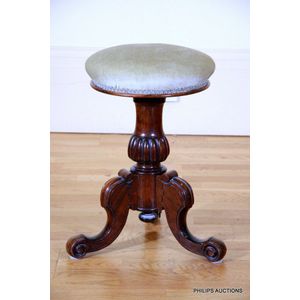Victorian Walnut Renaissance Revival Piano Stool
You must be a subscriber, and be logged in to view price and dealer details.
Subscribe Now to view actual auction price for this item
When you subscribe, you have the option of setting the currency in which to display prices to $Au, $US, $NZ or Stg.
- Victorian Period - The Victorian period of furniture and decorative arts design covers the reign of Queen Victoria from 1837 to 1901. There was not one dominant style of furniture in the Victorian period. Designers used and modified many historical styles such as Gothic, Tudor, Elizabethan, English Rococo, Neoclassical and others, although use of some styles, such as English Rococo and Gothic tended to dominate the furniture manufacture of the period.
The Victorian period was preceded by the Regency and William IV periods, and followed by the Edwardian period, named for Edward VII (1841 ? 1910) who was King of the United Kingdom and the British Dominions and Emperor of India for the brief period from 1901 until his death in 1910. - Fluting - A form of decoration found on many pieces of furniture, as well as ceramics, silver and clocks, in which round-bottomed grooves, of varying width and depth, are let into columns, pilasters, legs. As a general rule, flutes are cut in the vertical, though they may follow a turned leg in a spiral pattern. In cross-section, they may be described as a series of 'U' shapes, rising and narrowing at each end of the groove. Fluting is the opposite of reeding, with which fluting is often associated.
This item has been included into following indexes:
Visually similar items

A carved mahogany wine table inlaid in the Moorish taste, 19th century, the table inlaid in star, chequered and diamond point patterns in a variety of specimen timbers, with a raised relief caved edge, raised on a turned stem to a lavishly scrolled base wi

Vintage Australian pokerwork smokers stand decorated with kookaburra,gum leaf, and magpies, height 85.5 cm approx

A Victorian mahogany tripod based piano stool, 19th century, with maker's mark, Charles Wadman, Bath, no. 6693, with a shaped and reeded pedestal to sweeping legs with whorl feet, the stuffover seat upholstered in sage velvet, height 52 cm

A Victorian walnut piano stool, 19th century, the circular stool of adjustable height with a padded seat upholstered in tan velvet above a knopped and oak leaf and scroll carved pedestal with three curvaceous legs terminating in scroll feet; bearing a Brit
